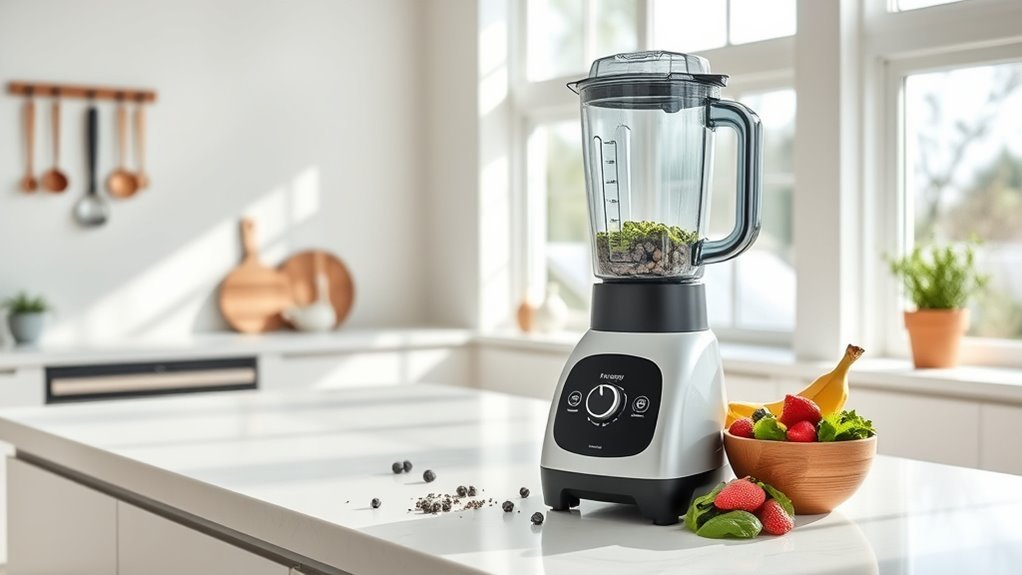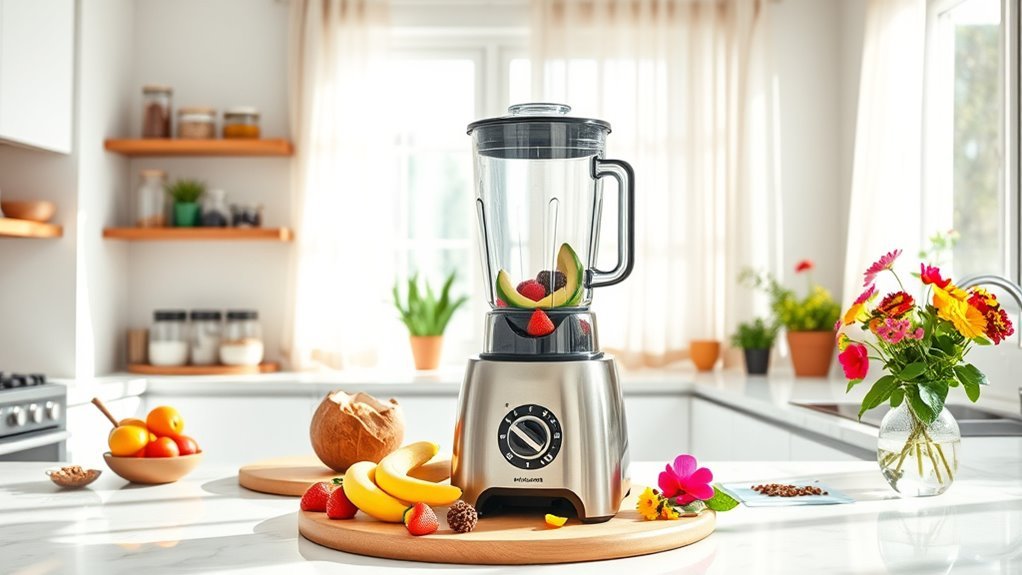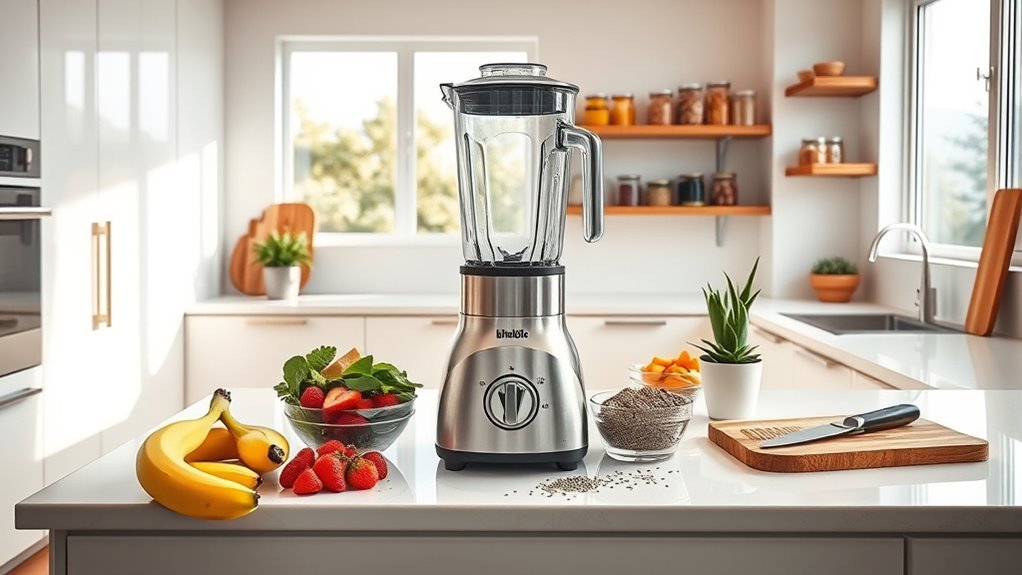We’ve tested dozens of countertop blenders, and let’s be honest—not all are created equal when it comes to smoothie bowls. You need serious power to transform frozen bananas and tough greens into that perfect spoonable consistency. We think the right blender makes all the difference between a lumpy disappointment and the Instagram-worthy creation you’re aiming for. The market’s packed with options at every price point, but which ones actually deliver?
What Makes a Great Smoothie Bowl Blender

Why do some blenders leave chunks of kale floating in your smoothie bowl while others create that Instagram-worthy thick and creamy consistency? It’s all about power and design. We’ve found that a powerful motor (around 1,200 watts like the Nutribullet Ultra) is essential for transforming fibrous kale and frozen fruit into silky smooth perfection in just two 30-second cycles. Variable speed settings make a huge difference too—you’ll want to start slow and finish at high speed, like the Vitamix Propel 510’s 1-10 options. Quality stainless steel blades (preferably six-pronged) will pulverize even stubborn ice cubes. The best blenders for smoothie bowls can handle thick mixtures without leaving anything unblended. And honestly, features like automatic shut-off aren’t just convenient—they’re lifesavers when you’re making multiple batches! High-performance blenders can also help in achieving a nutrient-rich diet by breaking down food more effectively.
Top-Rated Countertop Blenders for Thick Consistencies
Nearly all of our top-performing blenders for thick consistencies share one essential feature: serious power.
The Vitamix Propel 510 and A3500 Ascent Series are standouts, crushing tough kale and frozen fruit into perfectly smooth textures in under a minute.
We’ve found the Nutribullet Ultra surprisingly capable for its size, transforming fibrous ingredients into creamy smoothies in just two quick cycles.
For those who hate noise, Cuisinart Hurricane delivers with its 2.25 Peak HP motor—it’s among the quietest best blenders for smoothies we’ve tested.
Don’t overlook the Ninja Foodi Smoothie Bowl Maker either. Its 1,400-watt motor and Auto-iQ technology create restaurant-quality thick consistencies.
When you need to crush ice and blend frozen berries, these powerhouses won’t leave you disappointed. With proper care, these blenders can last over a decade, offering long-term reliability.
Power Considerations: Wattage and Motor Strength

The power behind your blender isn’t just a marketing number—it’s what makes or breaks your smoothie experience.
When creating thick smoothie bowls with frozen blueberries and fibrous greens, you need a motor base that’s powerful enough to handle the challenge.
We’ve found that the Ninja Professional Plus Blender DUO and Foodi Power Blender consistently deliver impressive results.
- For smoothie bowls, look for blenders with at least 1,000 watts of power
- The Nutri-Blender Pro with 1,000+ watts can process tough ingredients in fewer cycles
- Lower-powered Ice Crushing Blenders (around 850 watts) may require up to ten blending cycles
- Models like the Detect Duo Power Blender automatically adjust speed to prevent jamming
When shopping, remember: wattage isn’t everything, but it sure makes a difference when you’re staring at chunks in what should be a silky smoothie!
Essential Features for Perfect Smoothie Bowls
Creating spectacular smoothie bowls isn’t just about the ingredients—it’s about having a blender with the right features to nail that perfect consistency. We’ve found that Nutribullet models with high-wattage motors (like the Ultra’s 1,200 watts) are fantastic for pulverizing leafy greens and frozen fruits.
| Feature | Benefit | Example |
|---|---|---|
| Variable Speed | Control over texture | Vitamix Propel 510’s 1-10 settings |
| Preset Programs | Consistent results | Green smoothie setting on control panel |
| Advanced Blades | Smooth blending | Nutribullet’s six-prong design |
| Auto Shut-off | Prevents overheating | KitchenAid K400’s 45-second cycle |
Look for blenders with dedicated blending cups that double as personal smoothie containers. They’re not just easy to use for delicious smoothies but also versatile enough for frozen margaritas—bonus!
Budget-Friendly vs. Premium Blender Options

When it comes to smoothie bowl blenders, price doesn’t always dictate performance—but it certainly plays a role.
We’ve tested dozens of kitchen appliances across price points, and found that while budget options like the KitchenAid K150 do a great job with frozen drinks, premium models like the Vitamix Propel 510 handle tough ingredients more efficiently.
- Budget blenders ($125-200): Good for occasional use, might require multiple 40-second cycles, but still create decent smoothie bowls
- Mid-range options: Better motor power (around 1,000 watts), more consistent blending and processing
- Premium models ($400+): Higher price tag gets you faster results, typically in 30-second cycles
- Warranty considerations: Budget models often have 1-year coverage, while premium options like Vitamix offer 10 years
For most home cooks, personal blenders in the mid-range are actually easy to clean and versatile enough for daily use.
Tips for Creating Restaurant-Quality Smoothie Bowls at Home
Ever wondered why restaurant smoothie bowls look and taste so much better than homemade versions?
It’s all in the blending technique and equipment.
We’ve found that using a high-powered blender like the Ninja Foodi Smoothie Bowl Maker with its 1200WP motor makes all the difference for smooth, ice-free results.
For the Best texture, freeze your fruits beforehand—blueberries and mango work wonderfully.
And use just enough almond milk to get things moving.
Small batch blending in personal blender cups is ideal for thick consistency.
Oh, and timing matters!
Blend for about a minute total, maybe a bit longer for frozen desserts and icy drinks.
Most premium models have preset functions that’ll do the work for you, creating that perfect Instagram-worthy bowl every time.
Cleaning and Maintenance of Your Smoothie Bowl Blender
Cleaning your smoothie bowl blender properly can make or break its longevity—trust us on this one.
We’ve seen even the most lightweight jars deteriorate when peanut butter gets left behind in those hard-to-reach corners.
In our Tested Personal experience, most models make it easy to maintain with a few simple approaches:
- Immediate rinse with warm soapy water (especially after making sticky ingredients)
- Use the self-cleaning feature if available—just add water and a drop of soap
- Clean the fine mesh parts separately to prevent food particles from clogging
- Don’t forget those suction cups on the bottom—they collect grime too!
While some parts are dishwasher-safe, hand washing is generally better for blade longevity.
After our soup test, we found that cleaning right away prevents stubborn residue and makes your blender easy to take care of.
Frequently Asked Questions
What Kind of Blender Do You Need for Smoothie Bowls?
We’d recommend a high-powered blender (1000+ watts) with texture control, variable speed settings, and sufficient ingredient capacity. Look for durable jar materials, quick blending time, and easy cleaning methods for perfect smoothie bowls.
What Is the Best Personal Blender for Smoothie Bowls?
Based on blender comparisons and motor strength metrics, we’ve found the Nutribullet Ultra is the best personal blender for smoothie bowls, with its 1,200-watt power consistently delivering lump-free, creamy results for thick mixtures.
What Kind of Blender Is Best for Smoothies?
We’d recommend high-speed blenders with powerful motors (1000+ watts) for smoothies. Look for durable models with effective blade design, multiple speed settings, and easy cleaning. Budget options like KitchenAid K150 offer great versatility and warranty coverage.
Are Smoothie Bowls Actually Healthy?
Like garden harvests, smoothie bowls can be healthy treasures. We’ve found their nutrient density and vitamin sources provide health benefits, but beware sugar content and calorie myths that may affect weight gain.

